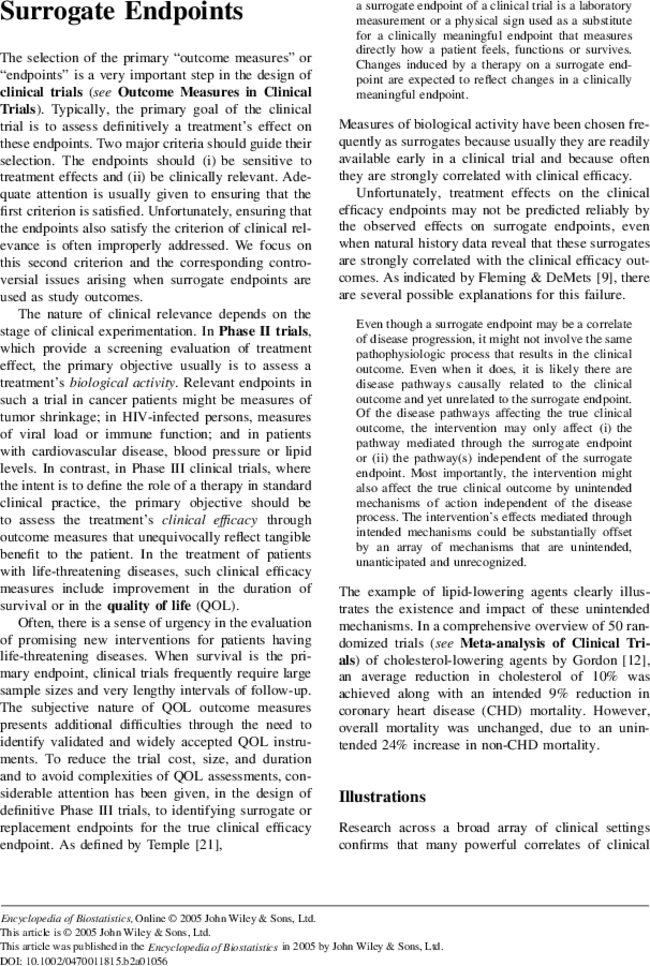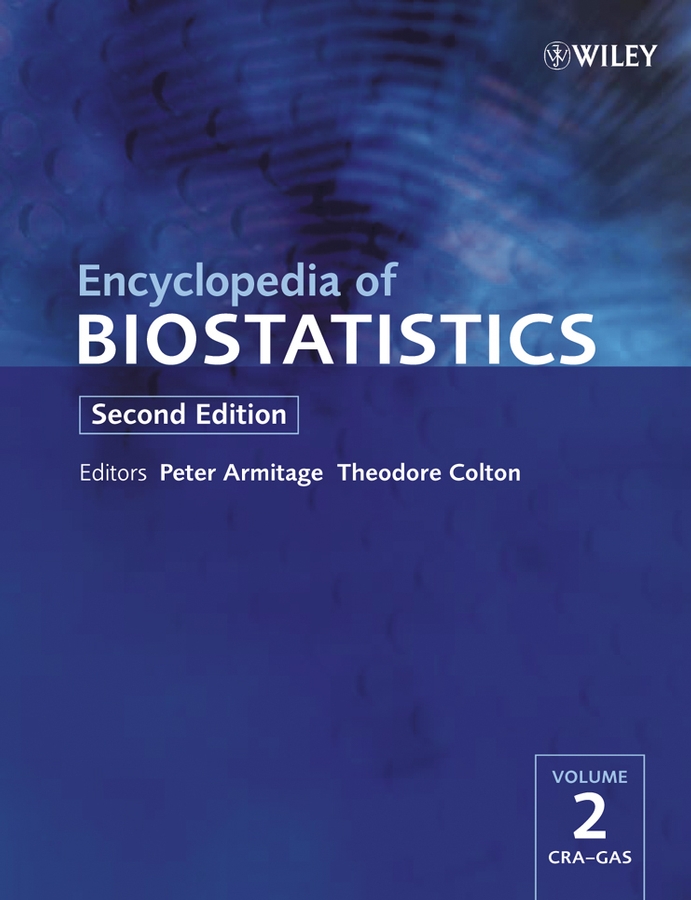Surrogate Endpoints
8
First published: 15 July 2005

References
- 1 Breslow, N. E. (1972). Contribution to the discussion on the paper by D.R. Cox, Regression models and life tables, Journal of the Royal Statistical Society, Series B 34, 216–217.
- 2 Breslow, N. E. (1974). Covariance analysis of censored survival data, Biometrics 30, 89–99.
- 3 Choi, S., Lagakos, S. W., Schooley, R. T. & Volberding, P. A. (1993). CD4+ lymphocytes are an incomplete surrogate marker for clinical progression in persons with asymptomatic HIV infection taking zidovudine, Annals of Internal Medicine 118, 674–680.
- 4 Cox, D. R. (1975). Partial likelihood, Biometrika 62, 269–276.
- 5
Daniels, M. J. &
Hughes, M. D.
(1997).
Meta-analysis for the evaluation of potential surrogate markers,
Statistics in Medicine
16,
1965–1982.
10.1002/(SICI)1097-0258(19970915)16:17<1965::AID-SIM630>3.0.CO;2-M CAS PubMed Web of Science® Google Scholar
- 6 DeGruttola, V., Wulfsohn, M., Fischl, M. A. & Tsiatis, A. A. (1993). Modeling the relationship between survival and CD4+ lymphocytes in patients with AIDS and AIDS-related complex, Journal of Acquired Immune Deficiency Syndrome 6, 359–365.
- 7
DeGruttola, V.,
Fleming, T. R.,
Lin, D. Y. &
Coombs, R.
(1996).
Validating surrogate markers: are we being naive?
Journal of Infectious Disease
175,
237–246.
10.1093/infdis/175.2.237 Google Scholar
- 8 Fleming, T. R. (1994). Surrogate markers in AIDS and cancer trials, Statistics in Medicine 13, 1423–1435.
- 9 Fleming, T. R. & DeMets, D. L. (1996). Surrogate end points in clinical trials: are we being misled?, Annals of Internal Medicine 125, 605–613.
- 10 Fleming, T. R., Prentice, R. L., Pepe, M. S. & Glidden, D. (1994). Surrogate and auxiliary endpoints in clinical trials, with potential applications in cancer and AIDS research, Statistics in Medicine 13, 955–968.
- 11 Freedman, L. S., Graubard, B. I. & Schatzkin, A. (1992). Statistical validation of intermediate endpoints for chronic diseases, Statistics in Medicine 11, 167–178.
- 12 Gordon, D. J. (1994),. in Contemporary Issues in Cholesterol Lowering: Clinical and Population Aspects, B. M. Rifleind, ed. Marcel Dekker, New York.
- 13 Kosorok, M. R. & Fleming, T. R. (1993). Using surrogate failure time data to increase cost effectiveness in clinical trials, Biometrika 80, 823–833.
- 14 Lagakos, S. W. & Hoth, D. F. (1992). Surrogate markers in AIDS: where are we? Annals of Internal Medicine 116, 599–601.
- 15 Lin, D. Y., Fischl, M. A. & Schoenfeld, D. A. (1993). Evaluating the role of CD4–lymphocyte counts as surrogate endpoints in HIV clinical trials, Statistics in Medicine 12, 835–842.
- 16
Lin, D. Y.,
Fleming, T. R. &
DeGruttola, V.
(1997).
Estimating the proportion of treatment effect explained by a surrogate marker,
Statistics in Medicine
16,
1515–1527.
10.1002/(SICI)1097-0258(19970715)16:13<1515::AID-SIM572>3.0.CO;2-1 CAS PubMed Web of Science® Google Scholar
- 17 O'Brien, W., Hartigan, P. M., Martin, D., Esinhart, J., Hill, A., Benoit, S., Rubin, M., Simberkoff, M. S., Hamilton, J. D. & the Veterans Affairs Cooperative Study Group on AIDS (1996). Changes in plasma HIV-1 RNA and CD4+ lymphocyte counts and the risk of progression to AIDS, New England Journal of Medicine 334, 426–431.
- 18 Pepe, M. S. (1992). Inference using surrogate outcome data and a validation sample, Biometrika 79, 355–365.
- 19 Prentice, R. L. (1989). Surrogate endpoints in clinical trials: definition and operational criteria, Statistics in Medicine 8, 431–440.
- 20 Schatzkin, A., Freedman, L. S., Schiffman, M. H. & Dawsey, S. M. (1990). Validation of intermediate end points in cancer research, Journal of the National Cancer Institute 82, 1746–1752.
- 21 Temple, R. J. (1995). A regulatory authority's opinion about surrogate endpoints, in Clinical Measurement in Drug Evaluation, W. S. Nimmo & G. T. Tucker, eds. Wiley, New York.
- 22 Tsiatis, A. A., DeGruttola, V. & Wulfsohn, M. S. (1995). Modeling the relationship of survival to longitudinal data measured with error. Applications to survival and CD4 counts in patients with AIDS, Journal of the American Statistical Association 90, 27–37.



